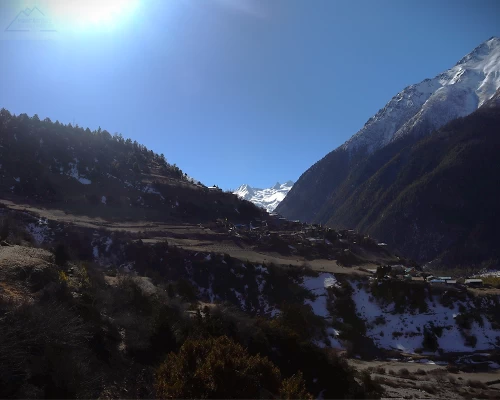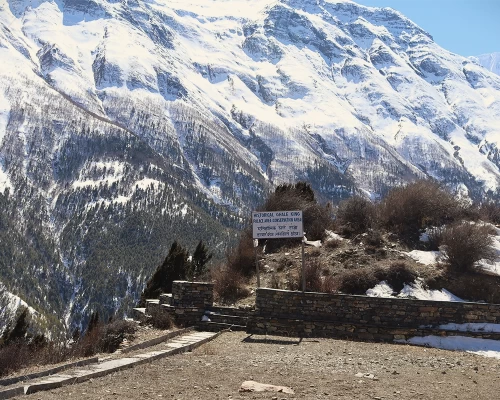Nar Phu Valley Trek is a newly opened trekking trail that will take you to the north part of Manang. This region was closed until 2002 for foreigners. However, the isolation and untouchability of modernization have preserved Nar Phu Valley & its rich culture. Nar Phu Valley Trek is one of the least crowded treks of the Annapurna region, which is perfect for anyone looking for a less crowded trail and raw experience. Nar Phu Valley Trek is also known as Hidden Valley Trek. To go on Nar Phu Valley Trekking, you will have to get a Nepal government permit. Tucked between the Annapurna and Manaslu regions, Nar Phu Valley will present you with unspoiled and pristine nature.
Nar Phu Valley Trek includes remote villages, high passes, massive glaciers, narrow canyons, dense forests, unique rock formations, ancient gompas, and many yaks & blue sheep. The entire region is extremely rich in culture and tradition. As you pass by villages, you will get a chance to look into the daily lifestyle of the locals and their practices. People are influenced by Tibetan culture, which has been kept intact for centuries. On the way, you will come across gompas and monasteries that will also give you insight into the religious part of the region.
Along with cultural richness, Nar Phu Valley Trekking will present you with stunning views of Himalayan mountains like Mt. Manaslu (8,163m), Mt. Dhaulagiri (8,167m), Mt. Annapurna (8,091m), Mt. Gangapurna (7,455 m), Tilicho Peak (7,134 m), Lamjung Himal (6,983 m), and many other mountains. Similarly, talking about the difficulty of this trek, Nar Phu Valley Trek is a challenging trek. The trail includes many steep sections. You have to walk around 6 to 7 hours daily. Therefore solid physical fitness with good health is a must.
Nar Phu Valley Trek will take you above 5,400 meters, which means there are also chances of altitude sickness. Altitude sickness or Acute Mountain Sickness (AMS) is a common illness with high elevation journeys. However, a perfectly planned itinerary with enough rest days for acclimatization can help avoid AMS.
Nar Phu Valley Trek begins with a long drive from Kathmandu to Chamje. From Chamje, you will gradually ascend to Phu Village via Dharapani, Koto, and Meta. You will have a rest day at Phu, which you will utilize to explore the village and its ancient monastery. The trail then takes you to Nar village, where you will take one more day of rest day. Next, you will ascend on a rugged, steep trail and reach the top of Kang La Pass, from where spectacular landscape views. Further, you will drop down to Ngawal village and head towards Manang. One more rest day in Manang, and you descend to Chame, from where you drive back to Kathmandu.
We, Mountain Rock Treks & Expedition, have been running Nar Phu Valley Trek for an extended period. We are a team of professionals equally passionate about traveling and exploring new places. We assure you that you will have one of the best trips of your life with us. For more information regarding the Nar Phu Valley Trek cost or anything else, please contact us anytime.
Why Nar Phu Kang La Pass Right For You?
- Less Crowded
Nar Phu Valley with Kang La Pass is an isolated mountain valley with a raw Himalayan landscape and traditional Buddhist culture. Only about 3,000 visitors frequent this area, making it one of the most popular off-the-beaten-path destinations in the Himalayas. Trekking in Nar Phu is a pleasure now that tea houses are springing up.
The Nar Phu Valley Short Trek is a cultural, adventurous, and beautiful phenomenon. Among the trip's main highlights are a herd of yaks and wild goats, Gombas, glaciers, isolated ancient settlements, flowing rivers producing deep gorges, beautiful woods, stunning rock arrangement, and medieval distinct Tibetan culture passed down from their ancestors.
The rich cultures of the Nar and Phu people will also be available to you as the residents of these two villages have still maintained their rituals and way of life from the past. The Tibetan Buddhist tradition has significantly impacted the local cultures and customs.
- Flexible Itinerary
Nar Phu Kang La Pass Itinerary is just a general reference for trekkers. Still, it may need to be modified in rare circumstances because of outside variables beyond our control, such as rough weather, difficulty accessing it, a lack of housing and campgrounds, and unanticipated governmental decisions. The trek lead can decide on schedule changes or the necessity to divert to other routes and locations after discussing with the trek guide and keeping in mind the interests of the trek group as a whole.
What to Expect From The Nar Phu Valley Trek?
The Nar Phu Valley journey leads you to distant Nar and Phu villages close to Tibet over several high passes, lovely villages, lush woods, old monasteries, and small gorges. As the walk continues, you will pass spectacular chortens, herds of blue sheep, and some of the world's most pristine landscapes.
The Manang district is home to the two distinct villages of Nar and Phu. With gorgeous mountain peaks, Phu is situated at the meeting point of glacier valleys. Four holy monasteries may be found in Nar, a little more contemporary town. The Kang La Pass, at 5,320 meters, which connects Nar, Manang, and Neyshang Valley, is the highest point of our walk. With its mountainous vistas and old Tibetan culture, this secret valley is accessible by the Nar Phu hiking route. Views of Annapurna II, Manaslu, and Lamjung Himal can be seen all along the trail.
- Best Cultural Highlights
Due to its rich cultural legacy as a nomad country, breathtaking scenery of lovely mountains, and rugged Kang La Pass (5100m) on the route to join the standard Annapurna circuit path, the mysterious hiking in the unique valley has been increasingly popular day by day. This is one of Nepal's remote trekking destinations with lodge-to-lodge lodging.
The society that inhabits this valley has preserved its incredible regard for cultural diversity via family traditions. They believe their ancestors fled Tibet to keep their Bon-Po faith. It is a rare hidden gem to discover in the remote Himalayan regions inhabited by Tibetan origin tribes where they coexist with Mahayana Buddhism and ancient Bon-Po religion. In addition, hikers may explore the full Annapurna normal path while taking in stunning vistas of the magnificent Himalayan peaks.




.jpg)




